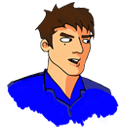Cargo Chaos (orginally called Fail Freighter) was by no means sticking to a strict set of rules or even a proper emulation of such a competition. I wanted to see what a 48 hour development time would be like and what it could yield. Scott suggested we use one of my simpler smart phone game ideas and create a working prototype over a weekend.
Design
The design of the project was mercifully easy and my job in this enterprise was easier than Scott’s. I love the design process and find a limited time can produce fantastic results by forcing you to make decisions. This isn’t a rule I follow strictly, I’m just used to working under deadlines.
Many people playing the concept pointed out that the objects didn’t stack well, as though I had somehow not managed to work out how to make objects stack. The main problem is if the objects fit together too well there is very little “wiggle” room when they are undergoing smaller vibrations.
While there is a certain logical sense to work on a more Tetris-like stacking system, this format would have relied on large waves to knock objects about. Much less fun in my opinion and some objects are structured to get players to do something specific rather than just present a challenge. The orange girder in level 4 qualified as a minor eureka moment when trying to figure out how to encourage players to stack upwards.
This isn’t a complaint but did put me in mind of the inventor of Sudoku being told that the problems would be easier if he gave them more starting numbers.
Well Duh....
Construction/Style
Graphically I chose to move quickly and create something both simple and colourful with large objects. I have a couple years of experience in vector drawing with CAD programs as a draftsman and ideally I would use Illustrator or another vector drawing program for this kind of project. Vector drawing makes modifications and size adjustments much easier, especially when optimising for different systems.
I don’t have a licence or the experience in the kind of Vector program I would want to use so I drove into the project using a combination of Google SketchUp and Adobe Photoshop. A bizarre combo but I find that I can do simple vector elements in SketchUp and anything more complex I can convert into a vector using an Image to CAD program and then edit in either Autodesk 3ds Max or SketchUp. Also I have commercial licenses in both of these programs (never underestimate the cost of software).
To start I picked the upper bounds of our intended devices and created a document exactly to this size. In this case we used Apple handheld products as our baseline (for their standardised resolutions and aspect ratio). This became the master document that I could transfer to my own iPhone to test quality and colour.
The boat was originally a rough drawing trying to follow the general shape of a shipping vessel. I imported this picture into SketchUp so I could create a crisp and clean version of the object that could be scaled and proportioned cleanly.
For the objects I tried to provide the details through layer styles and overlays wherever possible. Layer styles make the objects much easier to modify individual objects and keep the style unified. For more complex details (like the wood on the Zoo box), I used one of my favourite thingies, the Clipping Mask. Again this was all for precise edge conditions.
When I was trying to keep my boundaries hard and unblurred (useful for pixel perfect graphics or pixel art) I modified the image interpolation to nearest Neighbour. While I wasn’t looking for a pixel perfect edge condition I wanted to make sure my objects used the same edge styles where possible.
Challenges
The hardest element for me was creating the cover art and icon image. I am not a particularly gifted painter or drawer and I found this part stressful. The first attempt was free hand, done quickly, and I was not satisfied with the results. I find using a simple 3d program like SketchUp to be of enormous help when trying to get my perspectives right. For the icon I wanted big simple colours and shapes so that the image would read well very small. I may still come back to make the edges and colours cleaner. Initially I hoped that the image I created would be used for both title screen and icon but I found it worked as an Icon but not a title screen. This was created by taking my 3D image and cleaning it up so that it would read as a simple and clear image. I could have used any of my software to do this but SketchUp was great for quickly transferring object images into 3D objects. Any problems I could fix with my Tablet.
All in all I found the exercise to be fun and invigorating. Hopefully we’ll have crack at/on the sides of Ludum Dare.

